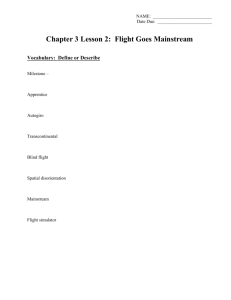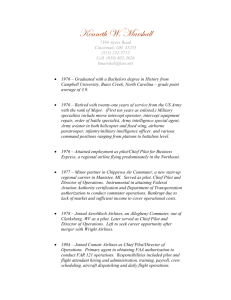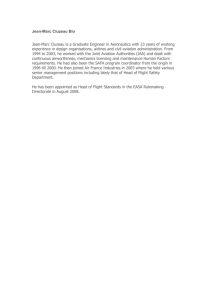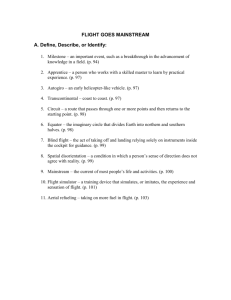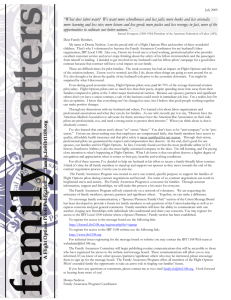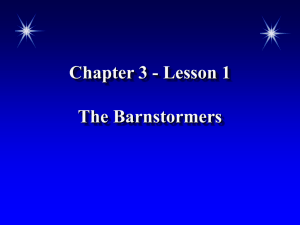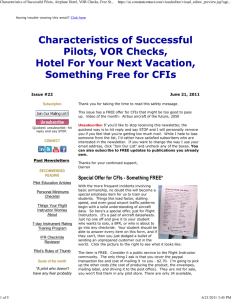Each of the words can be used once.
advertisement
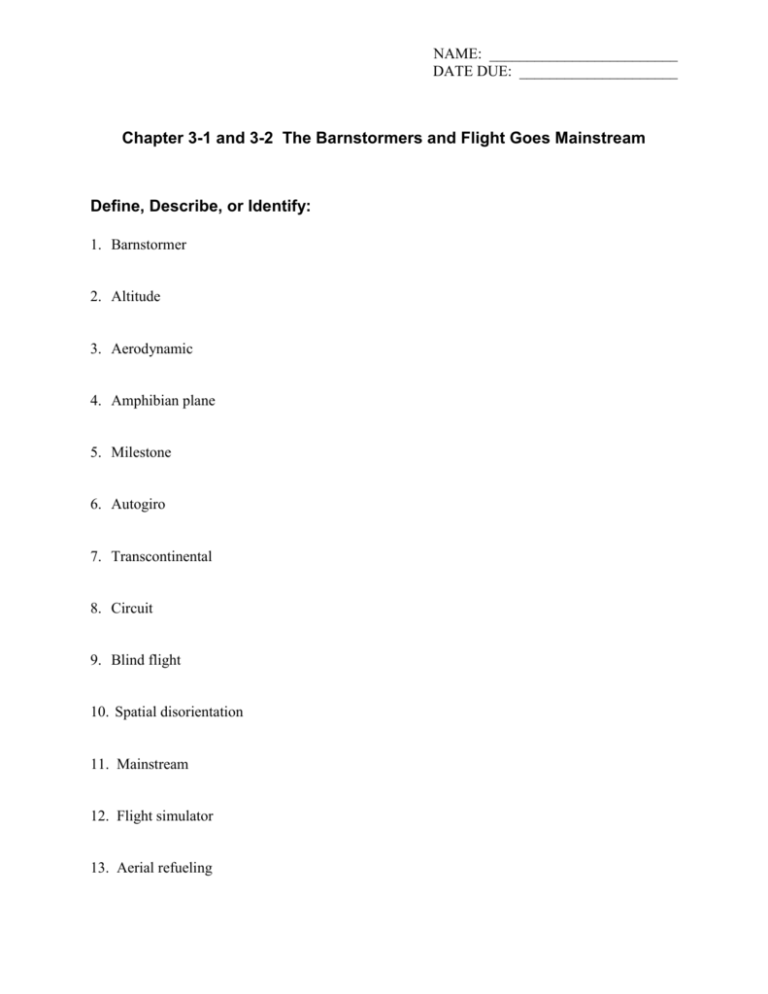
NAME: _________________________ DATE DUE: _____________________ Chapter 3-1 and 3-2 The Barnstormers and Flight Goes Mainstream Define, Describe, or Identify: 1. Barnstormer 2. Altitude 3. Aerodynamic 4. Amphibian plane 5. Milestone 6. Autogiro 7. Transcontinental 8. Circuit 9. Blind flight 10. Spatial disorientation 11. Mainstream 12. Flight simulator 13. Aerial refueling B. Chapter 3-1 Matching: Match the definition in Column A with the name in Column B. You may use each name only once. Column A Column B __ __ 1. This Chicago editor advised a young woman that Europe would be accepting of her. A. Lincoln Beachey B. Charles A. Lindbergh C. Robert S. Abbott D. Bessie Coleman E. Richard E. Byrd F. Phoebe Fairgrave Omlie G. William Randolph Hearst H. Anthony Fokker I. Bernt Balchen J. Margery Brown __ __ 2. This Dutch aircraft manufacturer encouraged an aspiring pilot from Chicago. __ __ 3. This person was the first licensed black woman aviator in the world. __ __ 4. At one point Orville Wright called this stunt flier “the greatest pilot of all time.” __ __ 5. He went on to even bigger things, but this famous American pilot started as a barnstormer. __ __ 6. The “air markers” this pilot developed showed aviators which way was north. __ __ 7. This barnstormer once wrote, “When I see an airplane flying, I just ache all over to be up there.” __ __ 8. He offered $50,000 to the first pilot who could fly across the United States in 30 days or less. __ __ 9. This Navy aviator, born to a famous Virginia family, explored the North and South Poles. __ __ 10. In 1929 he was the pilot on a historic trip to the South Pole. 2 C. Chapter 3-2 Matching: Match the definition in Column A with the name in Column B. You may use each name only once. Column A Column B __ __ 1. This aviator named his plane the Spirit of St. Louis to honor the men who had supported him. A. Charles A. Lindbergh B. David Myers C. Amelia Earhart D. James Harold Doolittle E. Wilmer Stultz F. William C. Ocker G. Anne Morrow Lindbergh __ __ 6. He made the first successful blind flight. H. Katherine Sui Fun Cheung __ __ 7. This sergeant’s work helped solve the problem of spatial disorientation. I. Frederick Noonan J. Carl Spaatz __ __ 2. As an aviator, she was best known for her 1931 flight to China over the North Pole. __ __ 3. On an early Atlantic crossing, this pilot landed in Wales instead of Ireland, and with only a gallon of fuel left. __ __ 4. She was a pioneer of transatlantic flight, but on her first crossing, she was a passenger, not a pilot. __ _ _ 5. He was Amelia Earhart’s last copilot. __ __ 8. This Army flight surgeon helped solve the problem of spatial disorientation. __ __ 9. She soloed after only 12 ½ hours of instruction. __ __ 10. He and his crew set an endurance record in the Question Mark and demonstrated the practicality of in-flight refueling. 3 D. True/False: Circle the T or F for the following statements. T F Bessie Coleman’s exploits were all the more remarkable given that she had left school after the sixth grade. T F In the days before television and theme parks, daredevil pilots would entertain crowds with their “flying circuses.” T F American aviators returned from World War I feeling so far behind the Europeans that they successfully pushed the US government to offer major funding and contracts for aircraft. T F Aviation advanced so far during World War I that by 1918 most Americans had seen an airplane and a good many had been up in one. T F For barnstormers, flying was less risky than it had been for combat pilots, but still dangerous. T F Phoebe Fairgrave Omlie ran a flying circus and then went to work for the government agency that eventually became NASA. T F Airplane engines became more reliable during the “golden age of aviation.” T F During the “golden age,” wealthy enthusiasts advanced aviation by offering prizes to pilots who reached certain goals. T F Richard E. Byrd was a brilliant aviator but he was so shy and had so much trouble meeting people that he held back both aviation and polar exploration. T F Some people believe that without the barnstormers, aviation might have died altogether in the United States after World War I. 4 E. Fill in the Blanks: Each of the words can be used once. accidents airmail airlines altitude contracts heads hemisphere French instruments Ireland jumbo magnetism manicurist markers pants parachutist pilots radios scarf train weld wings 1. Bessie Coleman had met Robert S. Abbott because his newspaper had sponsored a contest to find the best ___________________ in black Chicago. She won that contest. 2. To prepare to learn to fly in Europe, Coleman learned ___________ at night school. 3. On 14 November 1918, three days after World War I ended, the US government canceled $100 million worth of airplane _____________________. 4. In this period after the war, there was no commercial and private aviation and most people traveled from city to city by ____________. 5. Stunt pilot Lincoln Beachey could snatch a ________________ or a handkerchief off the ground using the tips of his __________________. 6. At the “flying circuses” of this period, wing-walking was a favorite stunt. To give spectators an extra thrill, some wing-walkers would stand on their _____________. 7. Phoebe Fairgrave Omlie’s air ______________________ were painted in 12-foot letters on the roofs of buildings all across the country. 8. During the golden age of aviation, pilots attained greater ________________________, and served as test ________________________. 5 9. In his 1929 trip to the South Pole, Richard E. Byrd and his team carried out scientific research on meteors, cosmic rays, weather and Earth's __________________________. 10. Spectators at the barnstormers’ shows sometimes saw dreadful ______________________, but the aviators certainly created an interest in flight. 11. During the 1920s, Charles A. Lindbergh toured as a wing walker and a _________________ in a barnstorming act, and then a pilot. 12. When Lindbergh reached the western edge of the British Isles on his transatlantic flight, he called down to the fishermen, “Which way is ________________?” 13. Today, ______________ jets fly from New York to Paris in less than one-third the time Lindbergh took. 14. Among the challenges Amelia Earhart coped with on her solo flight across the Atlantic were iced-up wings, instrument problems and a broken _________ in the exhaust system. 15. Other pilots had flown around the world and made their circuits in the northern _________________, where there is more land. 16. After Doolittle’s pioneering work in blind flight, manufacturers starting equipping planes with ________________________ and 2-way __________________. 17. Many early pilots took pride in their ability to “fly by the seat of their _________________.” But William Ocker and David Myers realized that pilots of the future would have to rely more heavily on instruments.. 18. Two things that helped bring aviation into the mainstream for Americans were ___________ service and commercial __________________________. 6

